How Canva took on Adobe by making design simple… and won?
In just over a decade Canva went from creating yearbooks for Australian high schools to over 135M users and a $40B valuation.
Melanie Perkins and Cliff Obrecht (now husband and wife) founded Fusion Books in 2007 allowing Australian students to design their school yearbooks.
A few years later, they were the biggest supplier of yearbooks in Australia.
And the foundations of Canva were put in place.
Then in 2013, the couple along with technical co-founder, Cameron Adams, launched Canva to a 50k-person waiting list.
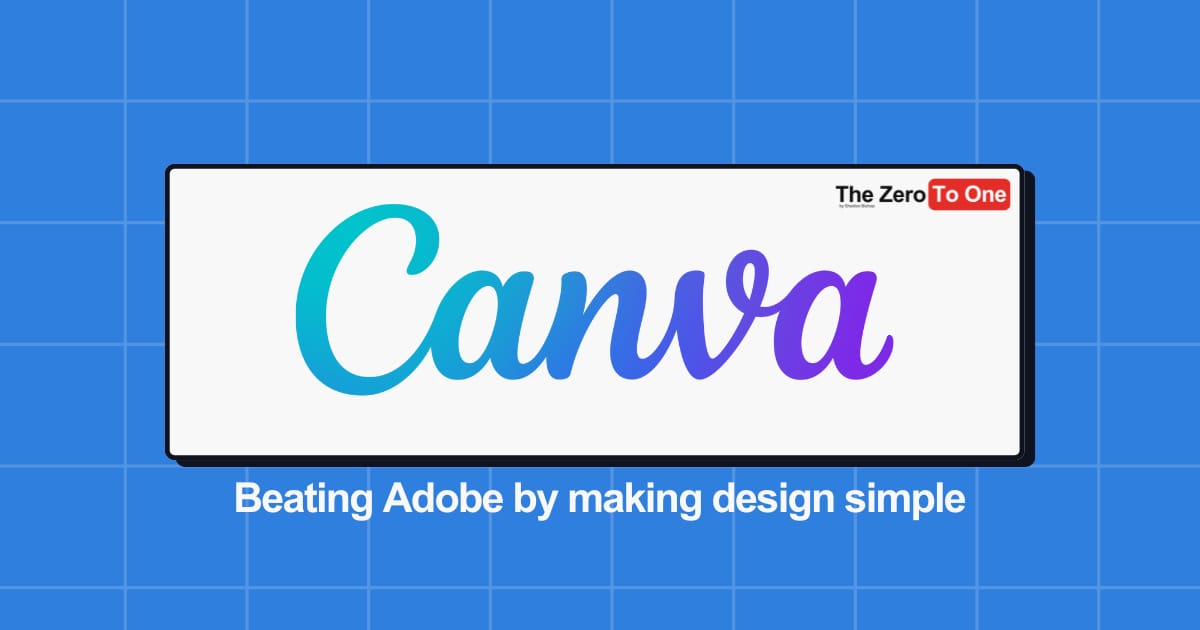
Along with their mission to empower everyone in the world to design anything and publish anywhere - the team had two ambitious goals in building Canva:
Build one of the world’s most valuable companies. 💵
To do the most good they can do. 🌱
Safe to say they achieved both. And in doing so, Canva has become one of the biggest success stories of the last decade - especially from a non-USA startup.
But let’s not get ahead of ourselves.
This is the story of how Canva went from Zero to One. 🚀
Business model: How Canva makes money
Canva’s business model is simple - but slightly different from a typical SaaS.
Usually, SaaS businesses choose between Freemium and Free Trial (among others) to convert users to monetization.
But Canva uses both.
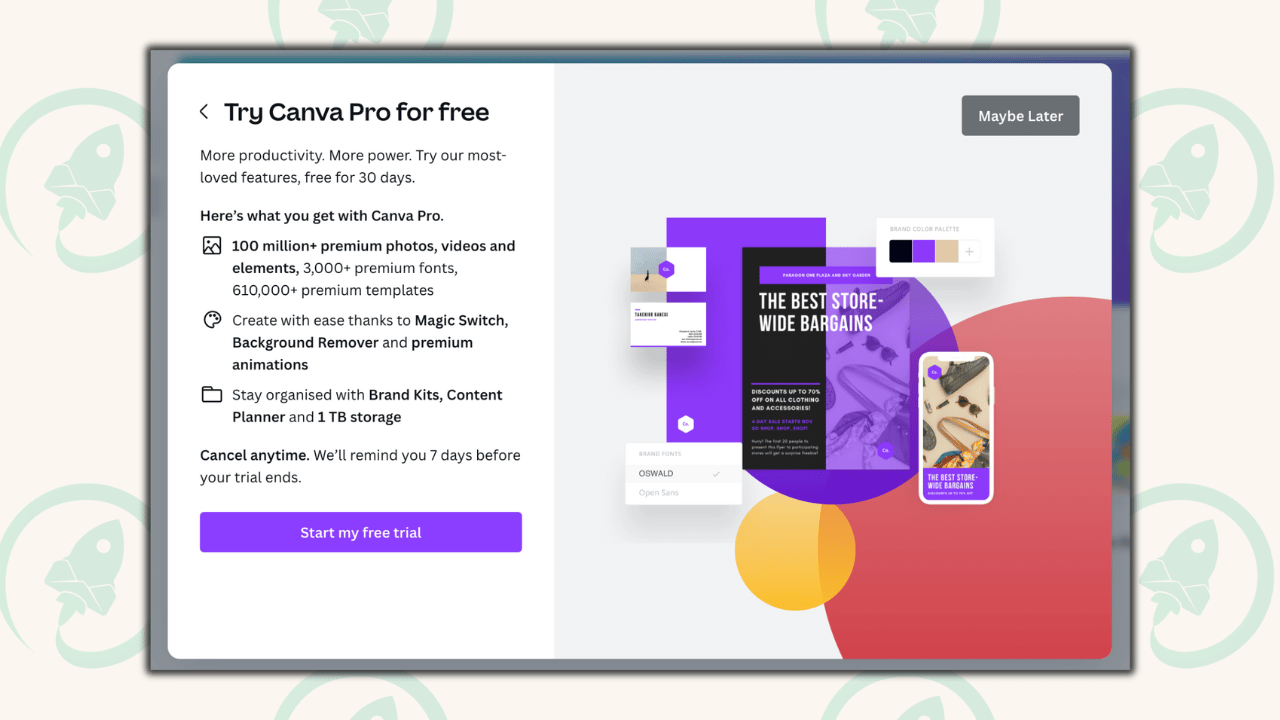
They have an awesome Free Plan that is sufficient for (probably) most people.
Then they have three paid plans: Canva Pro, Canva Teams, and Enterprise.
All of these offer more business features such as brand kits and more specialized features such as their background remover. With Enterprise offering a more tailored experience for companies that will have over 100 users.
Here’s a breakdown of their pricing:
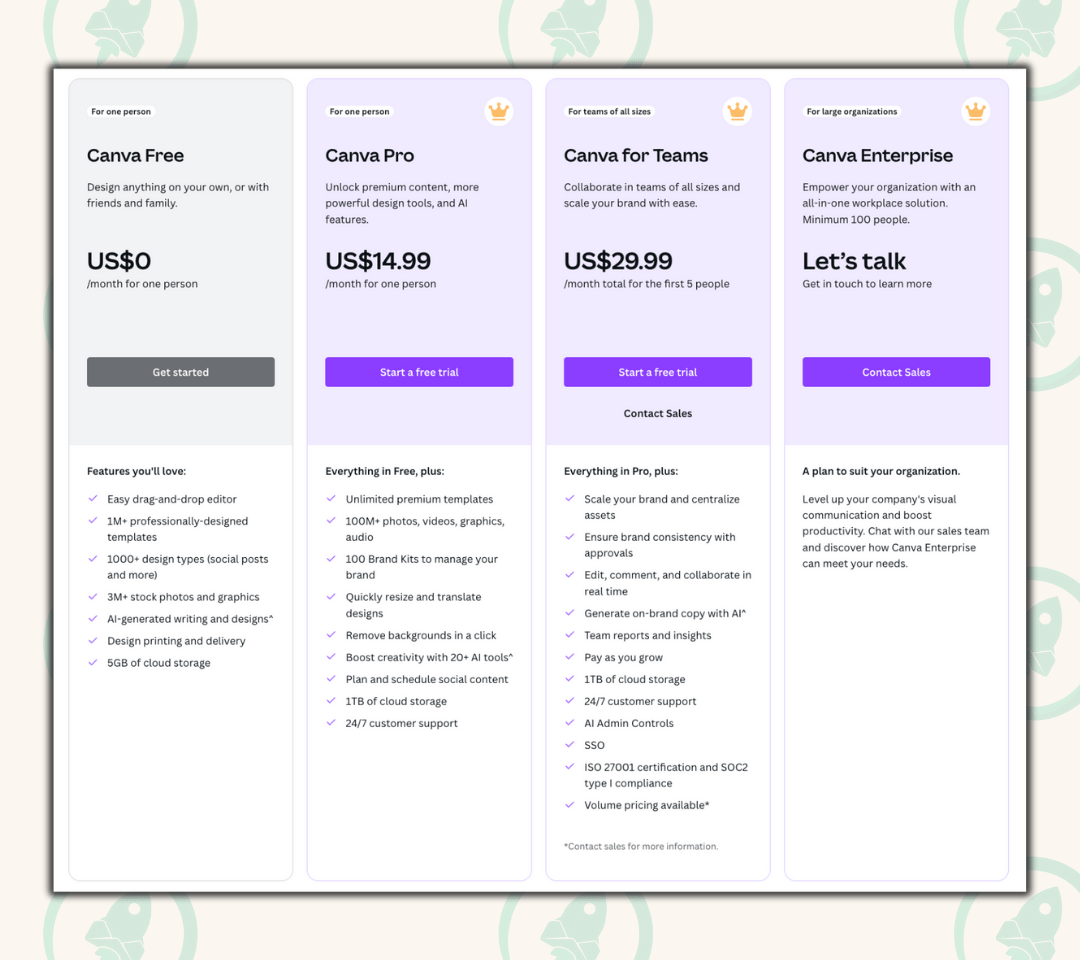
And then lastly, although not making money, Canva also offers free premium features for educators and NPOs - in line with them doing good!
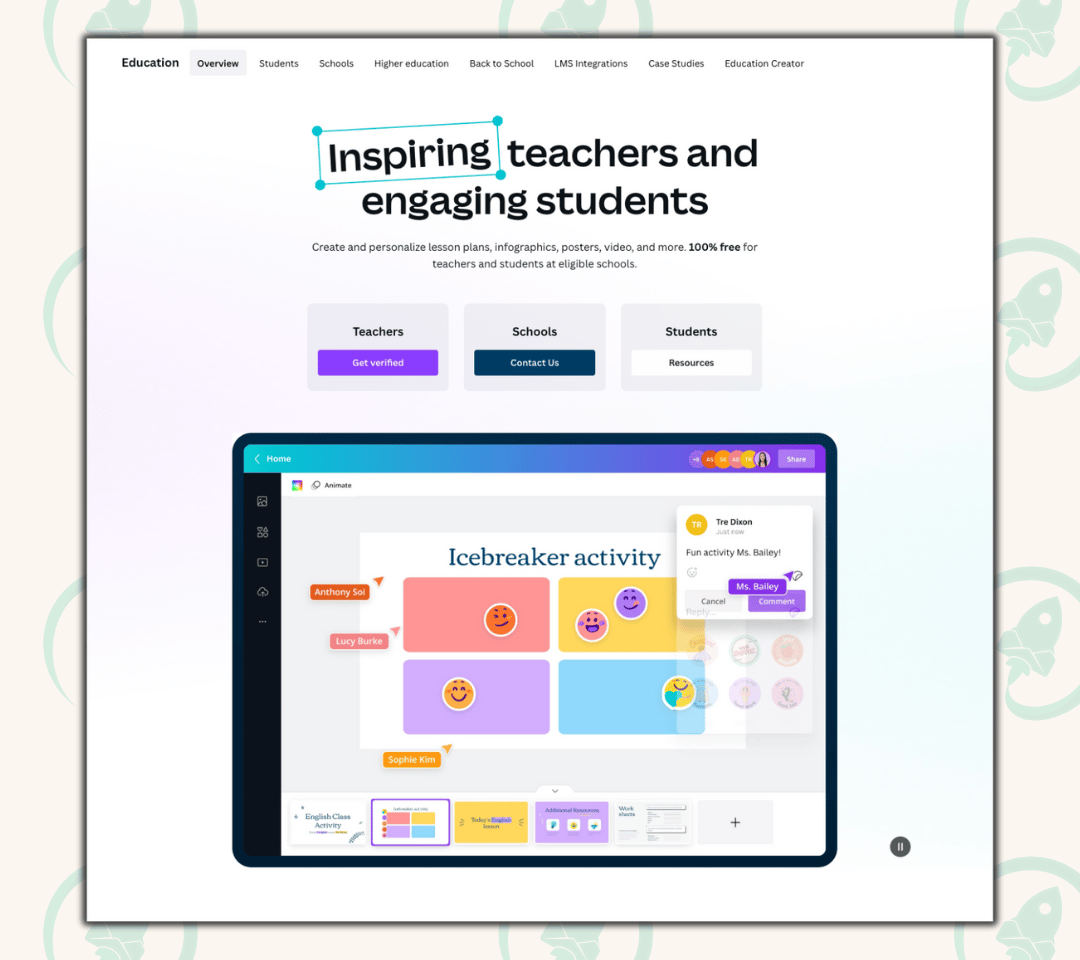
Canva’s Growth
Canva launched in 2013. But the idea for it started years before.
Melanie and her then-boyfriend Cliff were studying together at the University of Western Australia.
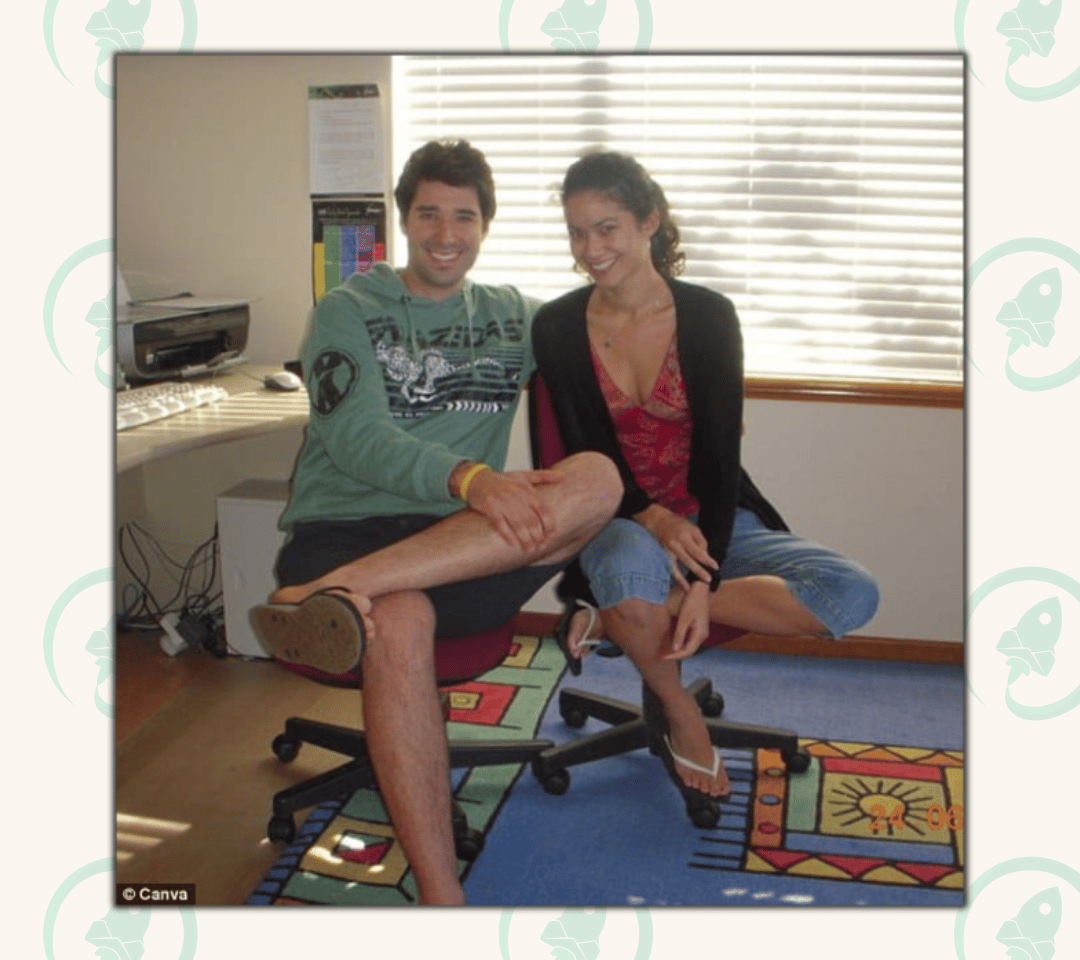
Melissa was studying Psychology and Commerce but was so passionate about design that she taught design programs to other students.
This is where she realized there was a problem.
It would take her students hours to learn the basics of the design tools on the market and the whole semester to become proficient.
A problem she felt was so obvious and needing to be filled that she dropped out of university to pursue it.
To build up some business acumen and money, as well as to test her hypothesis, she and Cliff started Fusion Books - a customizable yearbook tool for high school students in Australia.
Essentially an extremely niche testing ground for Canva.

The idea was a hit. It became the largest yearbook supplier in Australia and still runs profitably today.
This prompted them to go all-in on Canva.
They found a technical co-founder, Cameron Adams, to build the platform and raised $3M in Seed funding.
And so the journey began.

Canva built hype for their launch by creating a public waitlist - which reached 50k people by the time of launch in 2013.
By the end of 2014, Canva already had over 100k users, launched their iPad app, and had ~2M designs created on the platform.
They also welcomed Guy Kawasaki (renowned author, entrepreneur, and startup advisor) as their Chief Evangelist.
This is where things started to skyrocket.
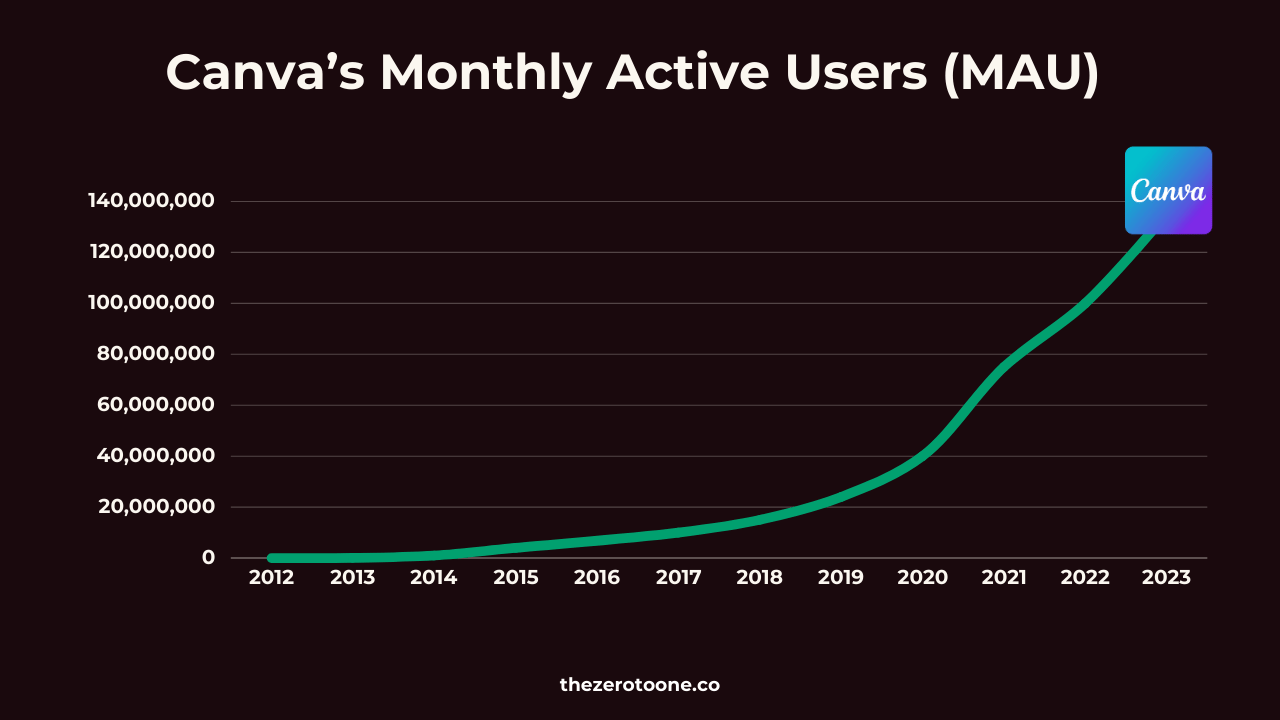
In 2015, Canva launched Canva for Work (now Canva Pro), reached 50 Canvanauts (employees), surpassed 50M designs created, and reached a valuation of $165M.
In 2017 Canva became profitable and launched a bunch of new features and products, including animations, Canva Print, their Android app, and launched in 100 languages.
Canva became a Unicorn in 2018 with their $40M investment round. And made their first acquisition, buying Zeetings to double down on presentations. They also hit 1B designs.
Their acquisitions and new products continued and by the end of 2021, Canva had over 75M MAUs and was valued at $40B after raising an additional $200M.
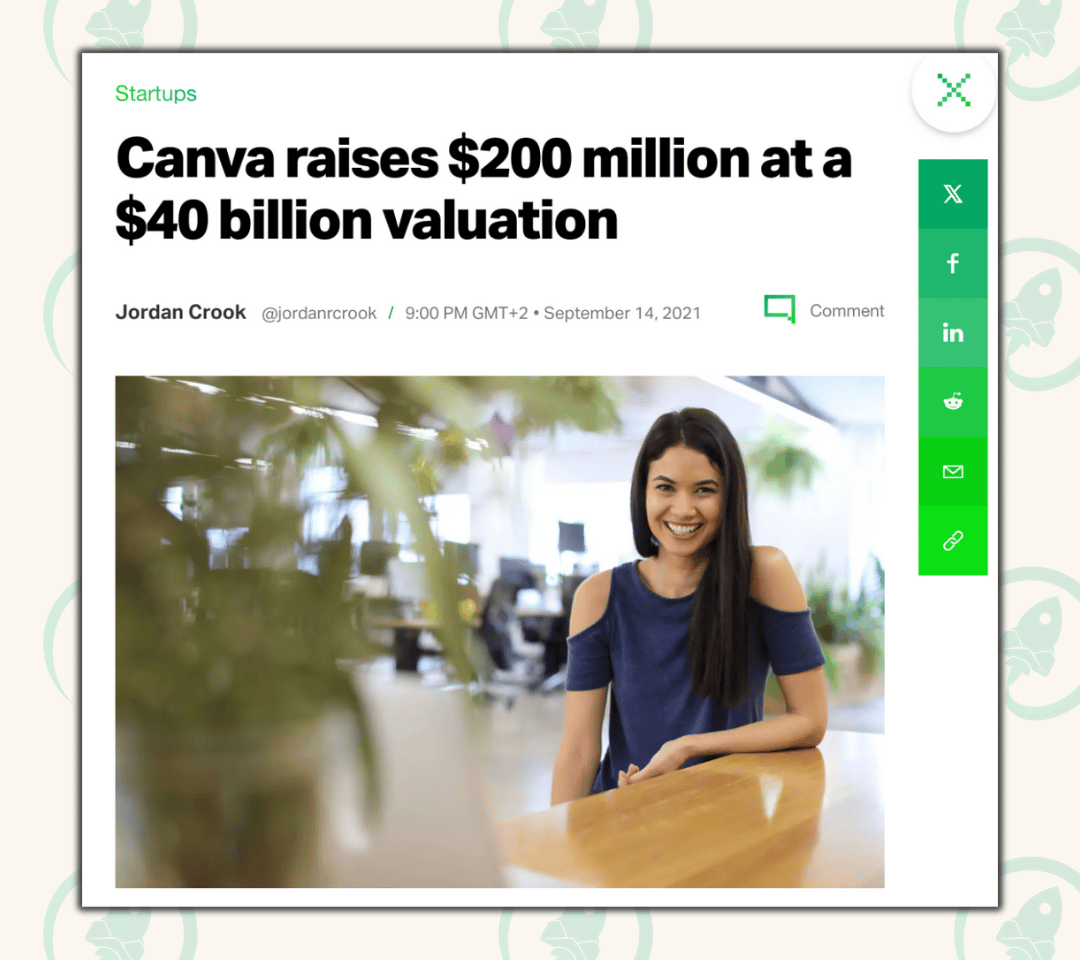
As of now, Canva has over 135M MAUs, over 4,000 Canvanauts, and more than 15B designs in the last decade - over 200 new designs created per second.
Key Success Factors (KSFs)
There have been so many reasons for Canva’s rocketship success. Here are four that stood out to me, particularly for Canva’s earlier stages of growth:
🌍 1. Solved a BIG, Painful Problem: As a non-designer, existing tools were challenging to use - and to make beautiful designs was almost impossible without months of training. Canva allowed anyone to make their visions a reality, both in their professional and personal lives.
👶 2. Simplified Everything: Everything at Canva is about simplicity - Simple to find. Simple to get started. Simple to use. Simple to share. Hotel? Trivago.
🪴 3. Created Valuable Content: Canva’s content marketing has been one of, if not its most important lever of growth. They have created a massive backlog of content that focuses on solving design problems and achieving design goals, how to use Canva, how to use content to grow, and much more. They also have an almost unlimited amount of specific landing pages to increase conversion - as well as having their own design school!
🌀 4. Inherently Viral GTM Strategy: Canva leaned into the inherent virality of their product, deciding their GTM strategy would be through Facebook designs for SMBs. Users would create content for their own businesses and then share it - FREE marketing. And even better, it aligned everyone’s incentives - the more viral the post, the better for the business and for Canva.
🌍 1. Solved a BIG, Painful Problem
It seems a bit ridiculous that it took so long for a tool like Canva to exist. And that’s exactly how Melanie felt, saying that the problem felt so obvious she feared someone else would beat her to it if she didn’t move fast enough.
But hindsight is always 20/20.
Back in the 2000s it probably seemed even more ridiculous that non-designers would need a tool for design.
But luckily for us, Melanie realized this counterintuitive nature of design tools from teaching design programs at university.
Her students struggled to learn the basics.
It took them entire semesters to proficiently learn a new tool.
Plus, for just about everything you wanted to create you needed another tool - which also took a semester to learn.
Think about Canva today - graphics, animations, videos, presentations, documents, graphs and visualizations, and more.
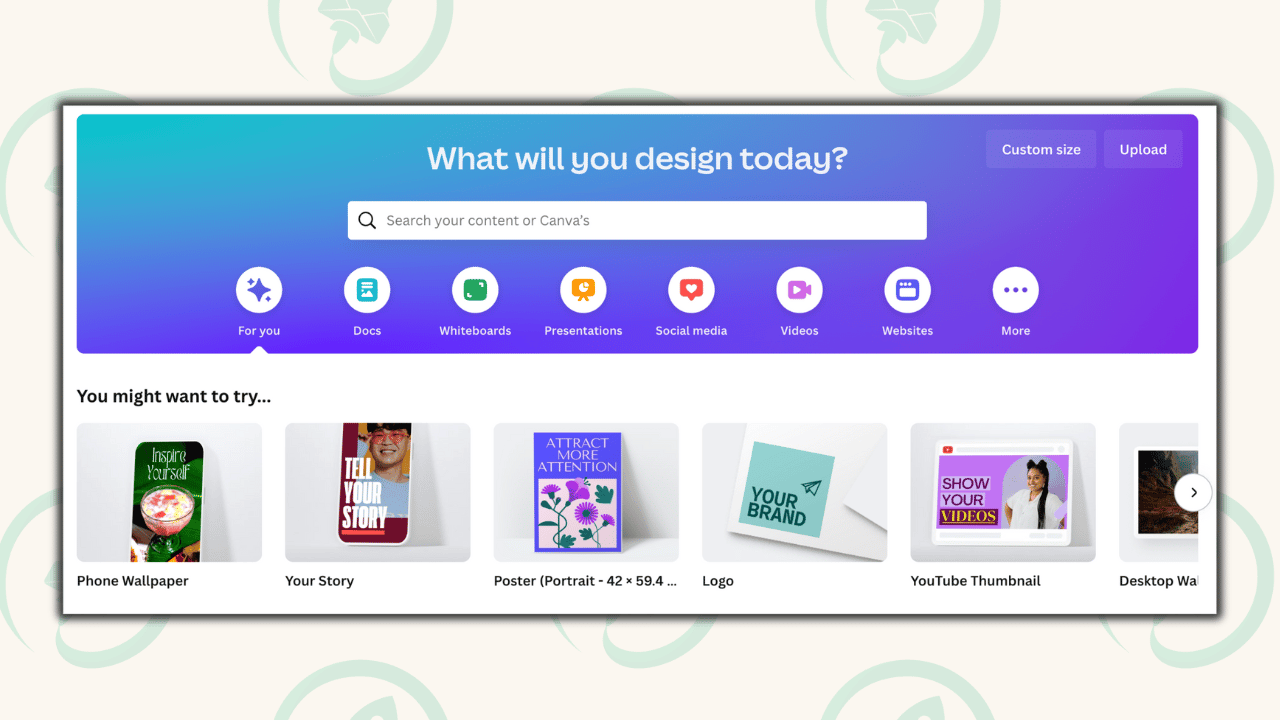
Before Canva you needed: Photoshop, Illustrator, Premiere, Powerpoint, Word, Excel, plus a whole bunch more.
Now I’m not suggesting that Canva does any one of these as well as the specialized tool - but it doesn’t need to - nor is it trying to.
Canva wants to be a suite of design tools hosted on one web-based platform. Giving you easier-to-use tools, simple templates, and more ways to collaborate.
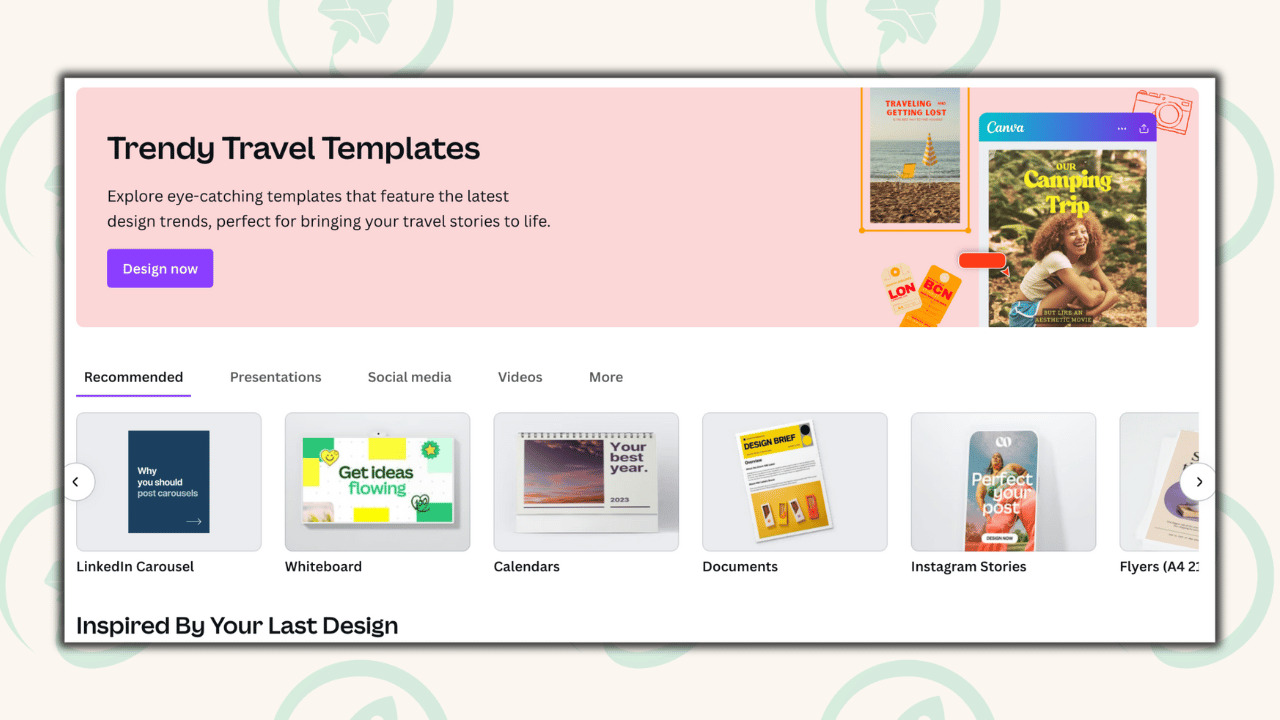
Before Canva, this didn’t exist. Before Canva non-designers generally felt hopeless.
Before Canva even launched they had 50k people on their waitlist - this idea was going to be huge!
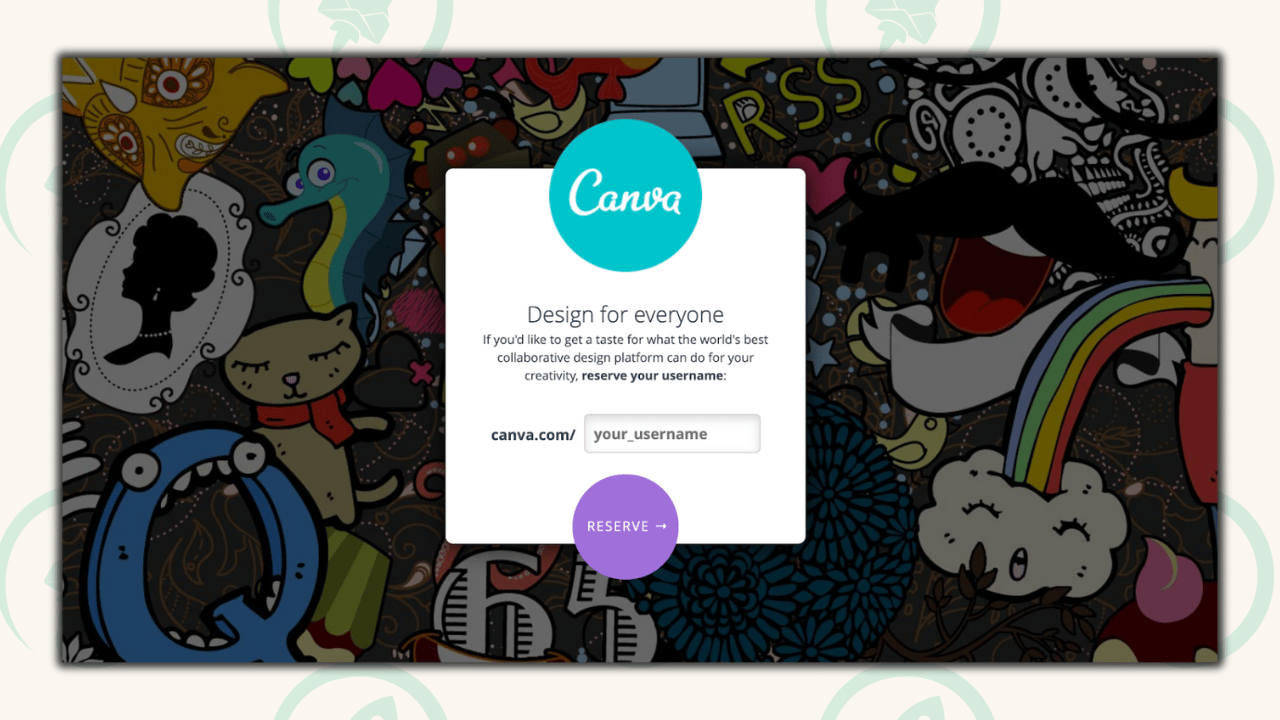
Now Canva has over 135M MAUs, in over 190 countries, and over 100 languages.
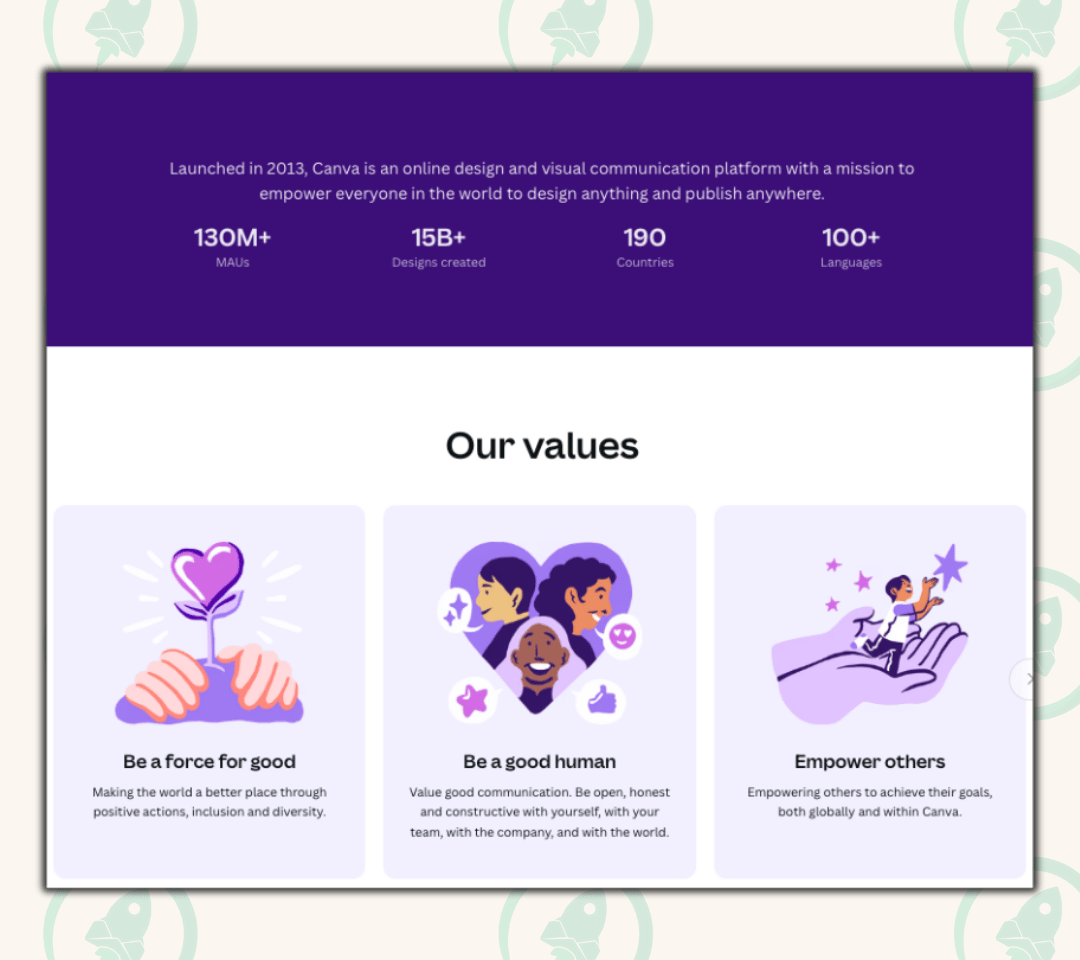
In a deep-dive on Karat (creating a bank for Creators), I mentioned how it’s better to solve a deeply painful problem for a small group of people, than a meh problem for a large group of people.
Well… Canva does both.
Canva solves a deeply painful problem for a MASSIVE group of people.
👶 2. Simplified Everything
Most often, the best solutions are the simplest.
And Canva is a great example.
Canva is the simplest solution.
Canva creates what I like to call a Simplicity Flywheel. Canva is simple to:
Find 🕵️
Get started 🌟
Use 🧰
Share 📢
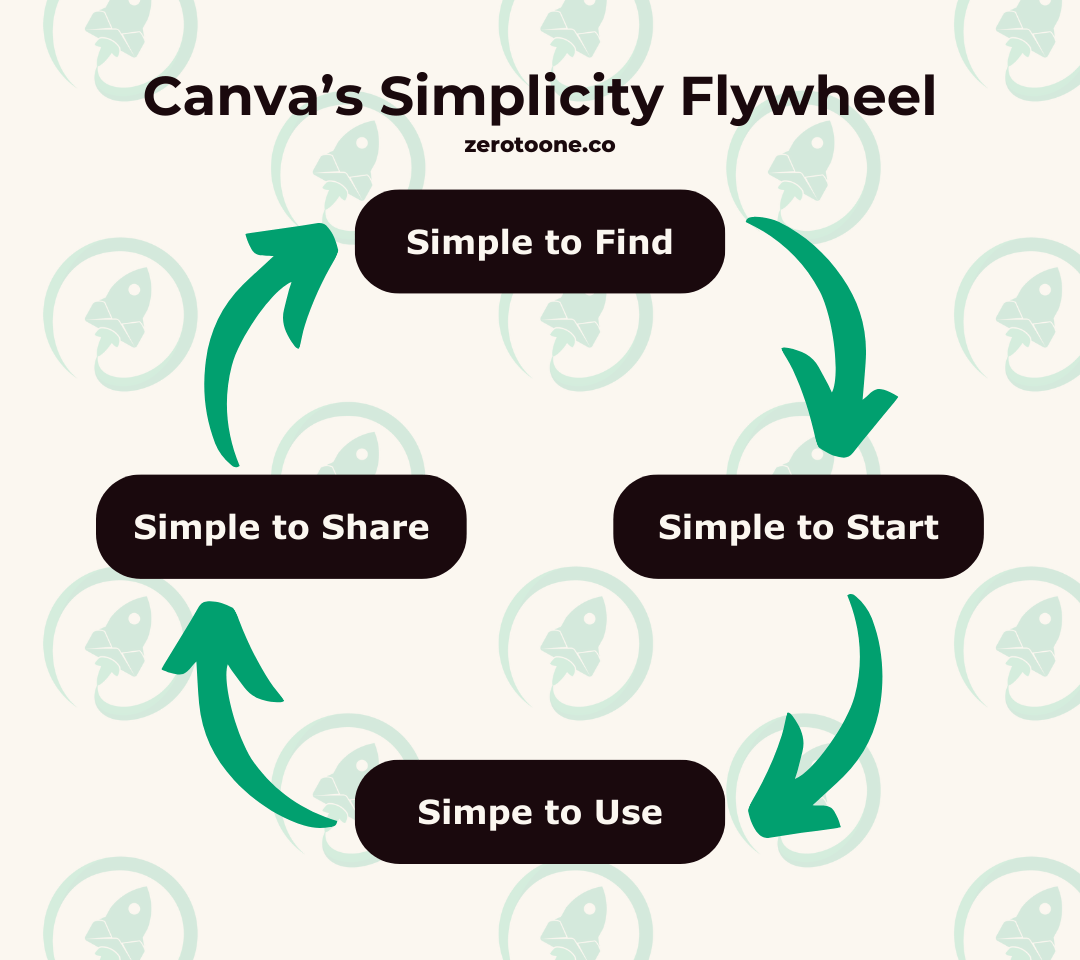
Simple to find 🕵️
Google something like “how to design a logo” and guess what pops up on the first page?
Canva.
Try something like “how to choose brand colors”.
Canva.
Okay one more, Google “how to make a YouTube thumbnail”.
Two videos of some guy telling me I can make free thumbnails that convert? Huh?
Oh wait - guess what platform he uses?
Canva.
With the Canva thumbnail tutorial right underneath it by the way!
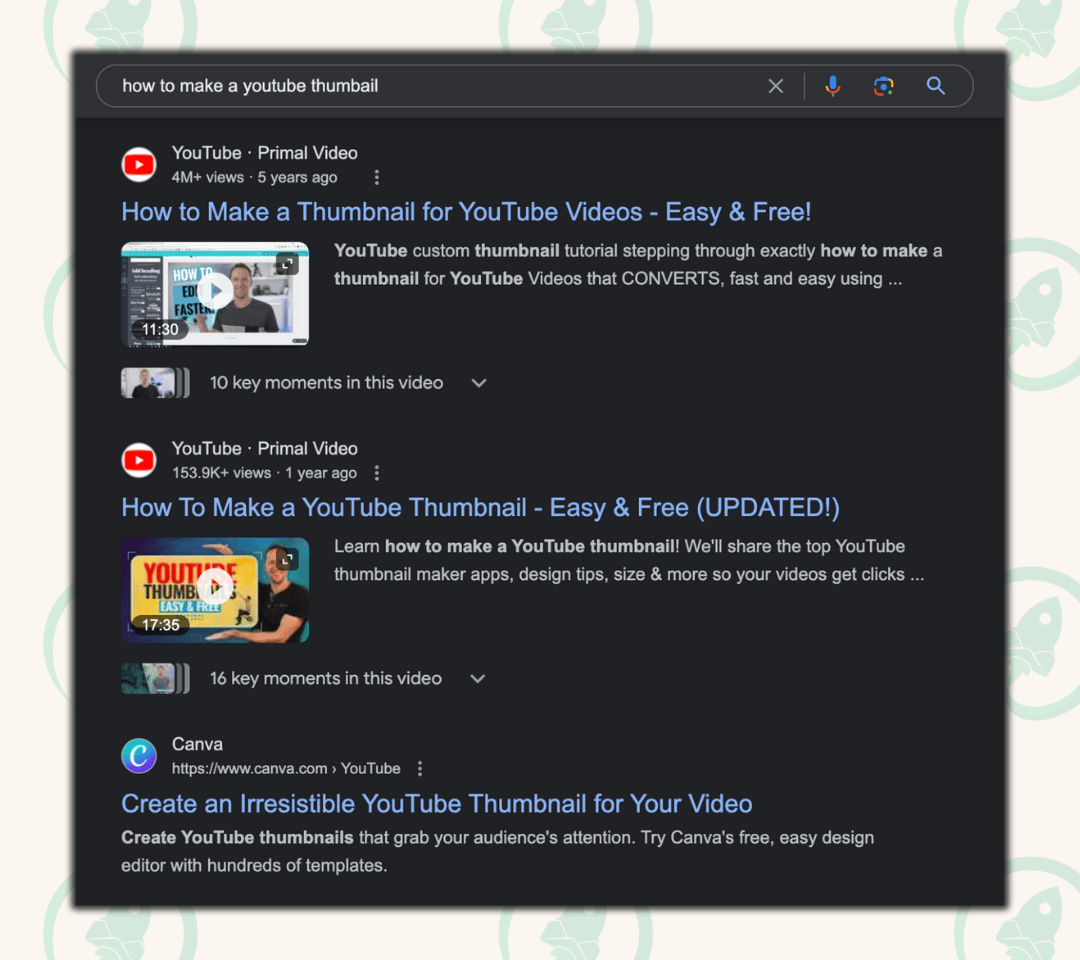
Canva has done an excellent job with content marketing - popping up on the first page for just about every use case imaginable, but more on this later.
Simple to get started 🌟
Canva has spent countless hours perfecting its onboarding process.
They identified that it wasn’t only the complexity of tools they needed to solve for, but also people’s confidence to design.
This is why they have structured their onboarding to get you to complete a design in a few minutes. If you don’t do it straight away, they make sure to remind you via email.
You get to see how quick and easy the platform is to use. And you make a cool design.
An instant confidence boost.
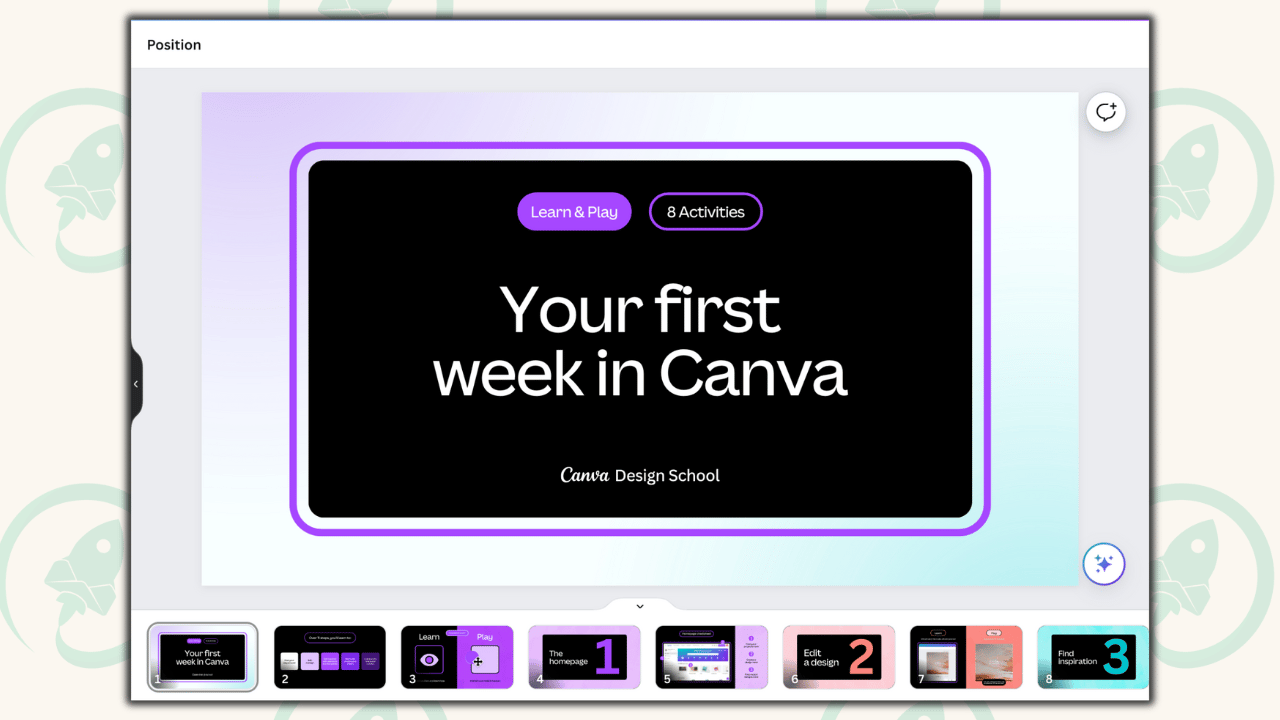
Canva also provides a ton of content on how to use their platform, how to achieve certain jobs (designs), and how to design better - making their users even more confident in getting started.
You may have noticed a common theme of content here - I promise its section is coming.
Simple to use 🧰
The core feature of Canva.
Create beautiful designs, without all the fuss of a highly technical tool like Photoshop.
It's simple to use - for everybody.
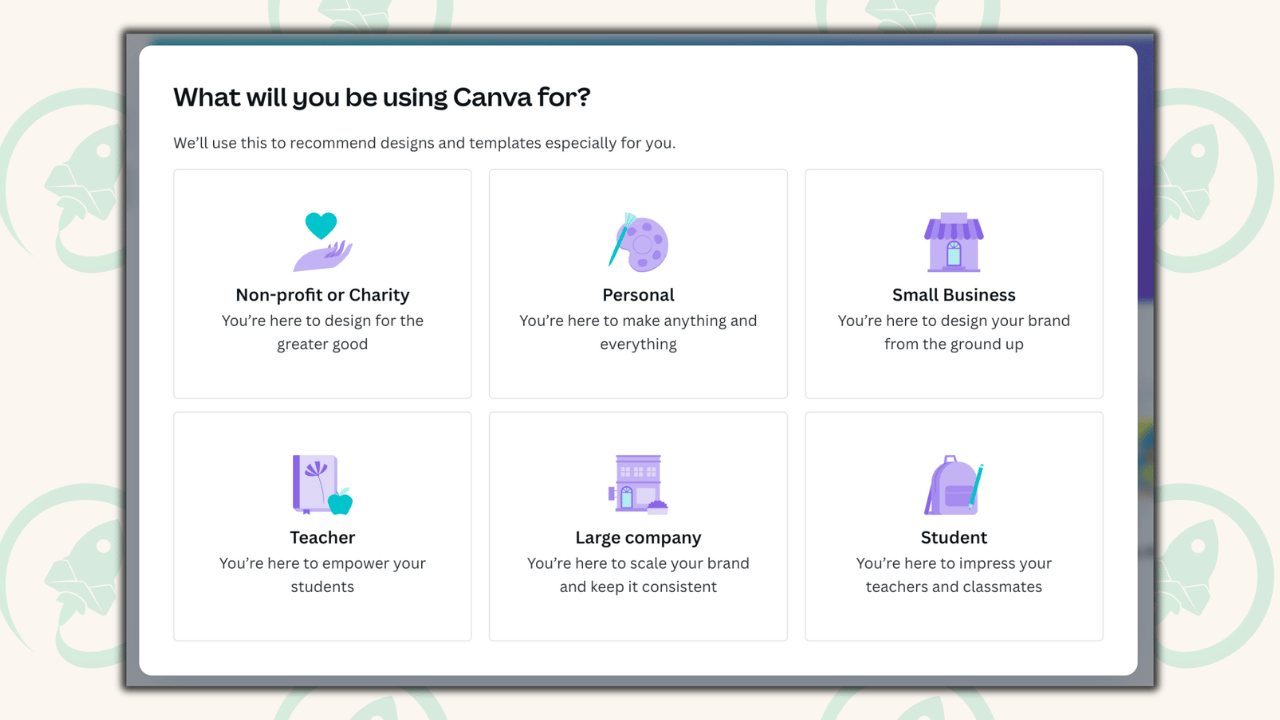
Canva has become their vision of an all-in-one design platform, where anyone can bring their creative visions to life.
No steep learning curves.
No need for more tools.
Simple to share 📢
One of the most critical parts of the flywheel is how simple Canva is to share.
Canva achieves this in a few ways:
Inherently shared through use (marketing on Facebook, Instagram, etc).
Integrates with a few social platforms, removing the friction to posting - allowing you to share and schedule designs from within Canva.
Simple to add team members and collaborate with them.
Users are proud of their designs, they want to share exactly how they made them.
The Canva Simplicity Flywheel then starts again.
🪴 3. Created Valuable Content
“The best marketing is education” - Regis McKenna, the key person behind marketing the first Apple Computer.
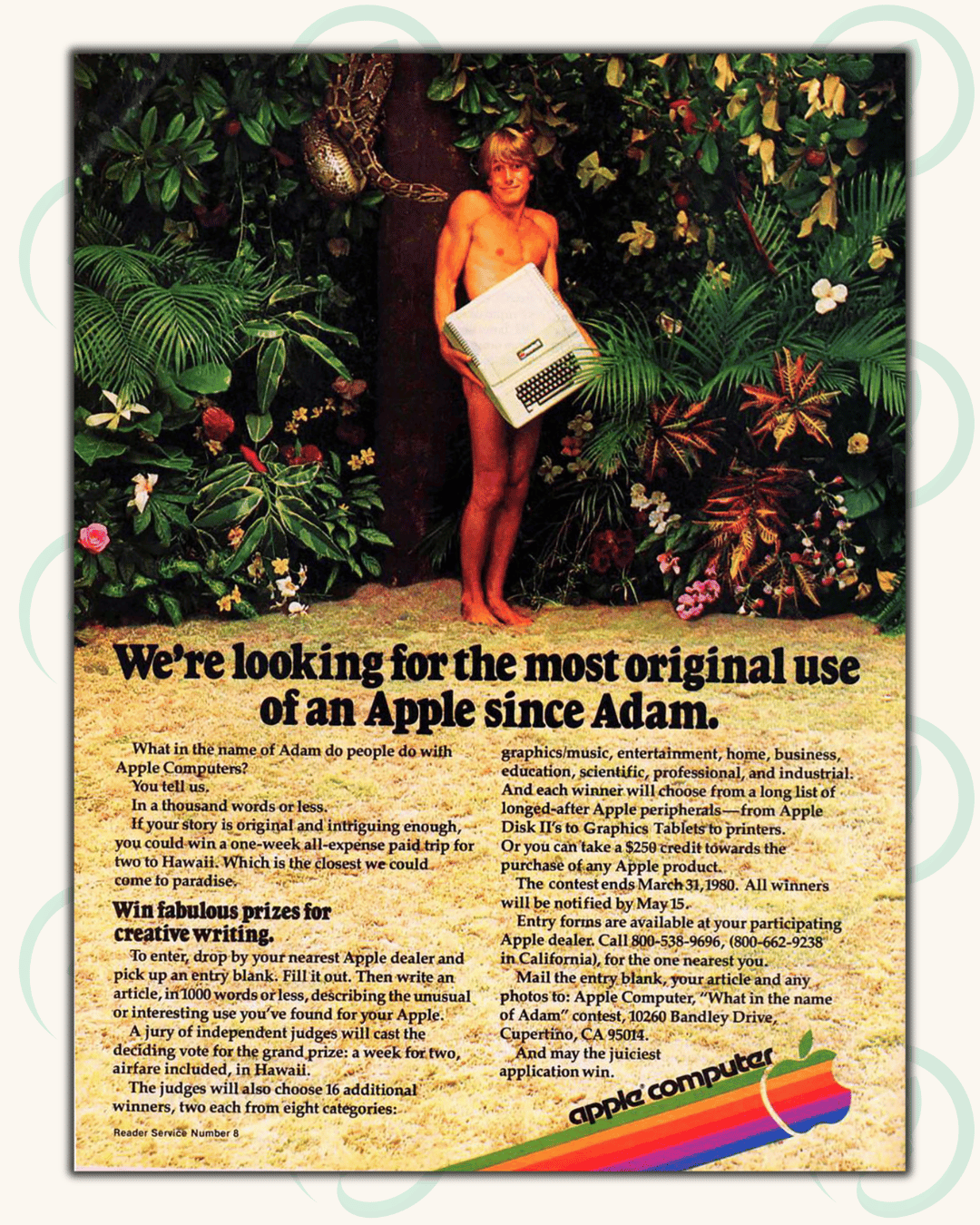
Canva is a prime example of this quote.
All of their content is made to help users create better designs - specifically on Canva.
Canva now dominates SEO by providing valuable content to their (potential) users.
In fact, Canva didn’t do any paid advertising until after 10M MAUs.
I’ve teased this part of the deep dive for a while now. So I guess I better deliver. Although Canva’s content strategy has been so incredible, I would have to actually try to not let it deliver value to you.
Strategy 🎯
Canva takes a wide-scope, but targeted, actionable approach to their content marketing.
Their key driver for content is creating value-adding pieces that help their users build up their design skills and get the most value out of Canva.
In fact, Canva launched with over one million templates, elements, and fonts.
This removes the friction to design - back to the simplicity.
How 📜
Canva does this by using a jobs-to-be-done intent strategy, i.e., solutions to tasks such as “how to create a LinkedIn carousel”.
They create for super-specific use cases.
But they create for all the use cases. And I mean ALL (the wide-scope part of their strategy).
Canva has six different blogs on just Wedding Photography - and how Canva can fit into it.
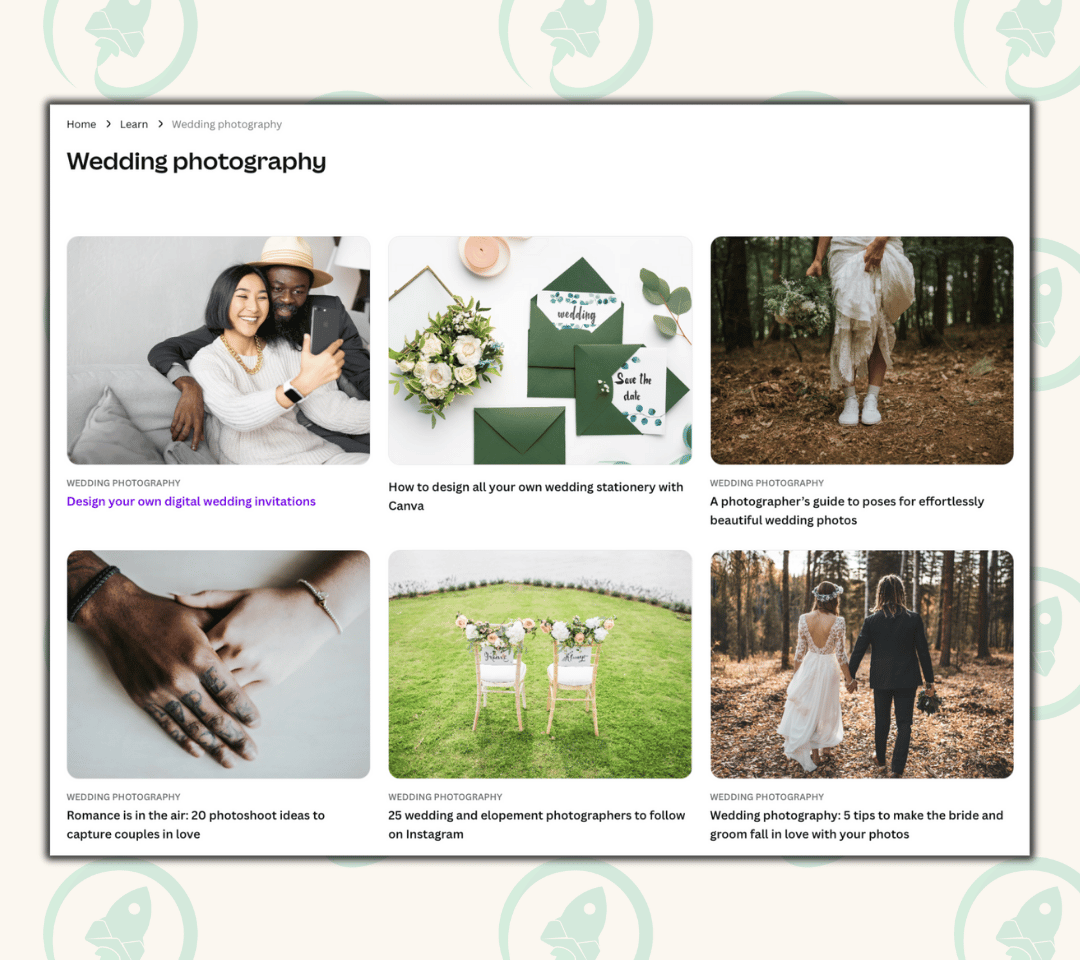
I mentioned above how Canva dominates Google searches. This is because they have just put out thousands of high-quality blog posts on just about every design topic imaginable.
They are experts in understanding their potential customers and their search intents - understanding what they could be trying to achieve and connecting them with a specific solution on Canva.
As in the earlier example: “how to choose brand colors” leads you to Canva’s article on their color palette generator, the psychology of color, how to choose colors for your business, and about eight of their YouTube videos on the same topic.
Safe to say I would be able to confidently choose my brand’s colors after this.
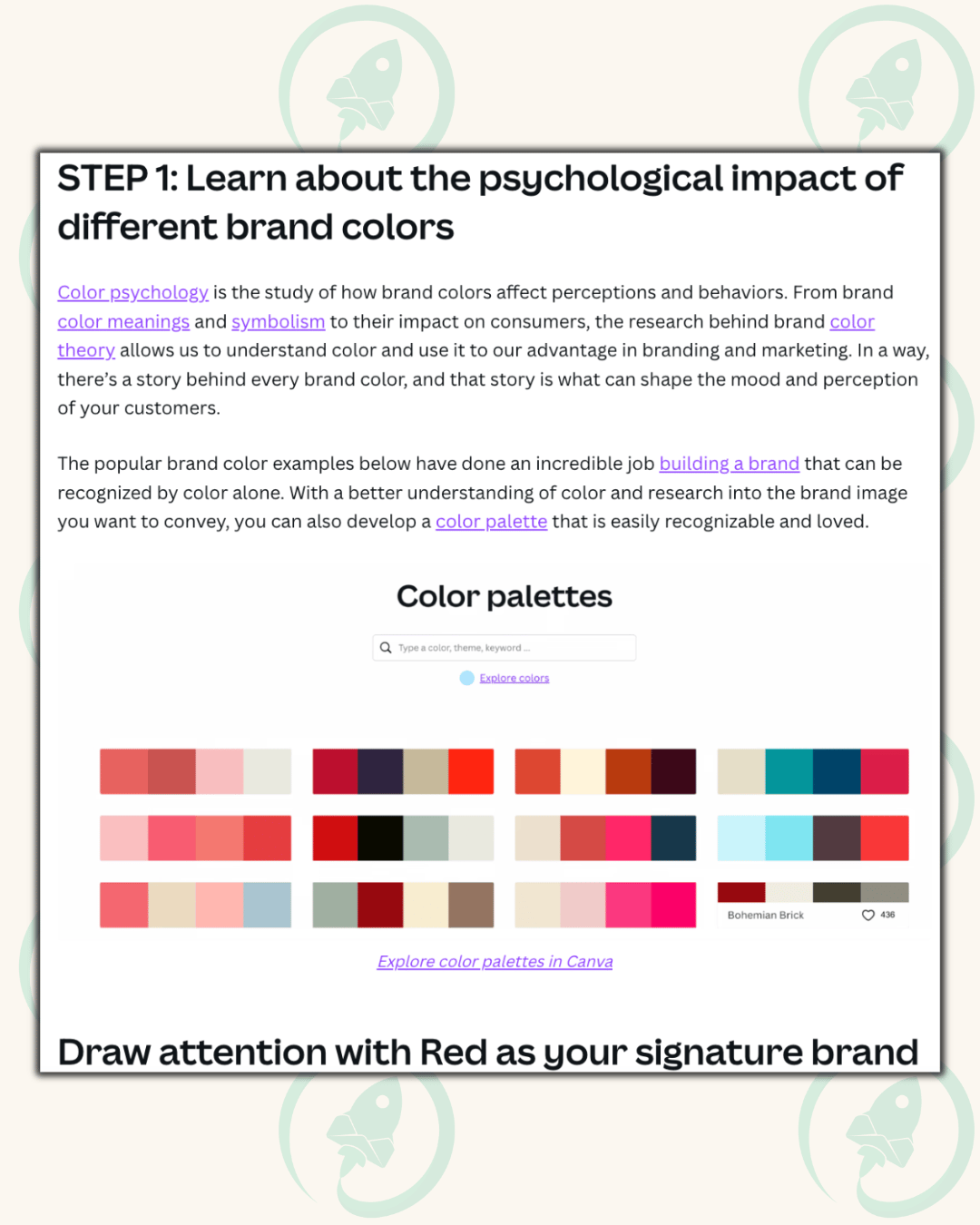
Canva gives each potential search intent its own landing page. Which in return builds backlinks for them (other websites linking to Canva). This is intentional.
Canva created tools and pages that can easily be referenced in journalists’ or bloggers’ content - giving Canva more domain authority and higher ranks.
To put this practically, imagine I’m a journalist writing about the rise of SMBs on social media.
I talk about how they’re creating unique content to build an audience. I want to help my readers as much as possible, so I find a tool that can create unique content for social media.
Guess what pops up as my first choice? (not this again… 🤣)
By now I hope you guessed it.
Canva.
And so I link Canva in my article. This not only boosts Canva’s domain authority, but also sends users directly to Canva.
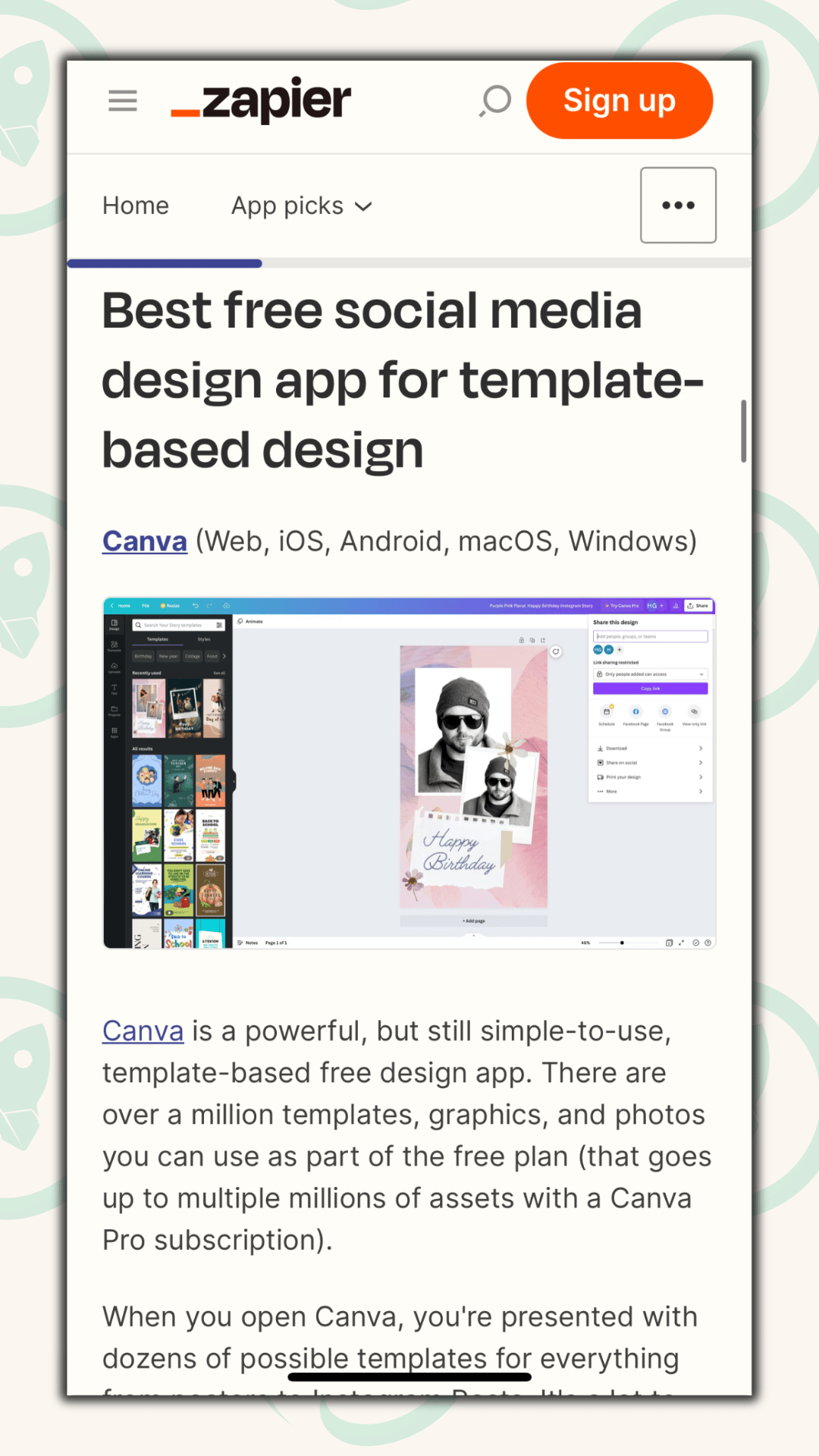
Canva also uses two more interesting ways to achieve its content goals:
Staying on top of trends: For example, during Covid, Canva produced a lot of content around Zoom, background templates, articles on how to design a background, and new landing pages.
Building a design school: Canva has its own dedicated design school to help you become a better designer. This builds brand loyalty as well as helps users get better results with Canva - which means they are more likely to upgrade to the paid version and stay on it for longer.
Why 🧩
It’s simple.
Focusing on education and not selling brings your users closer to repeat value - and that’s the best sales tool out there.
🌀 4. Inherently Viral GTM Strategy
Canva had a brilliant GTM strategy.
They noticed there was a huge rise in businesses using Facebook, in particular SMBs.
But the thing was, SMBs didn’t have design teams or professional designers. Nor could they necessarily afford to hire any. So they needed alternatives.
And so Canva went straight for this segment.
Not only was this a correctly identified gap, but it was tactically amazing for Canva - and they knew it!
SMBs wanted their designs in front of as many people as possible.
So did Canva.
They had created alignment in goals.
But not only that, the reason SMBs were flocking to Facebook was because at the time it was a great organic distribution channel. Meaning they got tons of free traffic.
This meant Canva got in front of millions of users for free, from the work of their users.
Canva created plenty of Facebook templates to draw more users in, who then used these templates to post on Facebook - driving referrals as users invited their colleagues and spread the word to fellow business owners.
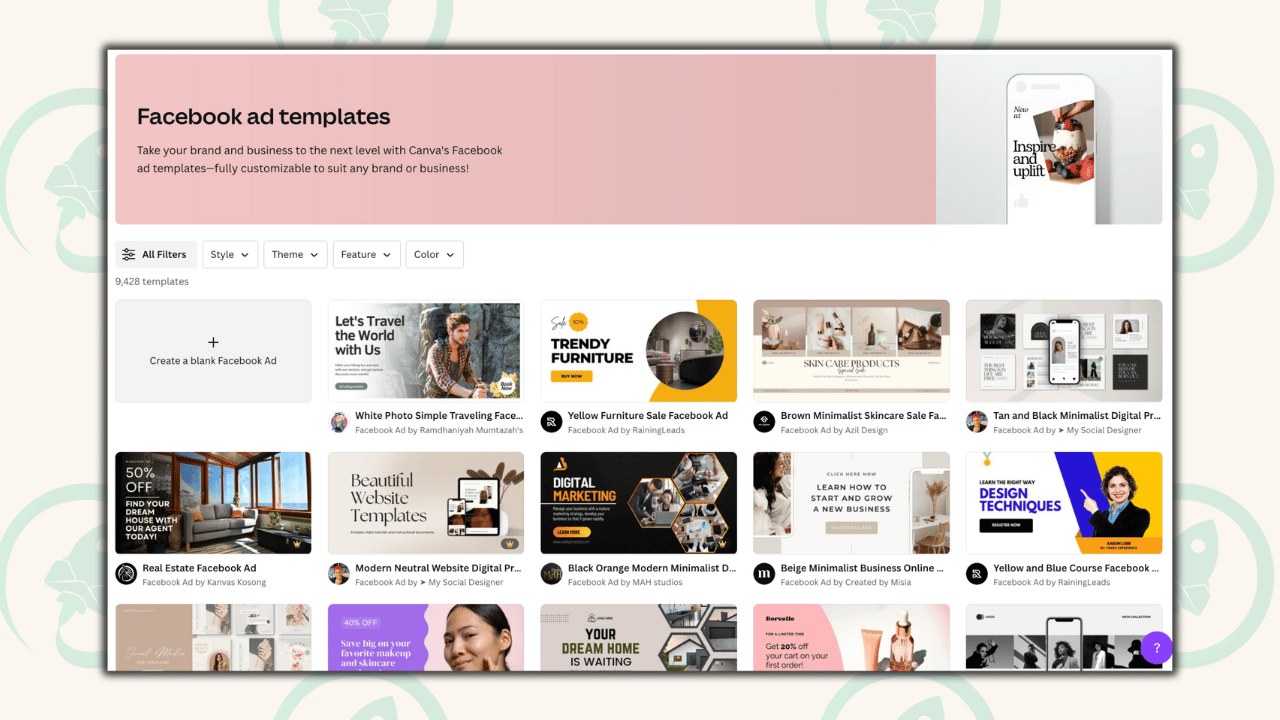
Canva didn’t stop here though, to increase this inherent virality even more they made sharing designs frictionless - one click on Canva to post straight on Pinterest, Facebook, or Twitter.
In doing this, Canva used a small number of users to spread the Canva word to many.
Oh and don’t forget, people are proud of the things they design - meaning they wanted to share how they created them.
And they created them with Canva.
Actions you can take to replicate Canva’s success
There is so much to learn from Canva - here are four key actions you can take and replicate into your business:
Introduce scarcity 🔢
One cool way Canva grew before even launching was to use a waitlist.
It’s nothing new nowadays - but still, a lot of people don’t use it.
A waitlist helps test for interest in an idea, but also by using it to limit access to your product, you get the benefit of scarcity.
Canva grew its waitlist super creatively.
They showed people the cool designs and templates from Canva - but you couldn’t get in.
However, you knew that some people were allowed in.
How you may ask?
Canva started to generate buzz within the design community and similar groups who needed design tools.
They reached out to the press, blogs, podcasts, and conferences to offer them early access for their audiences.
That’s how you got in early. That’s how you became a cool kid (at least I’m guessing it made you cool).
Also, anyone who Tweeted about Canva usually “coincidentally” reached the top of the waitlist.
Canva was awesome at generating hype through scarcity.
It shows. 50k people were on the waitlist at launch.
It’s a powerful tool to grow.
People want what they can’t have.
The key to scarcity is you want to be publicly oversubscribed.
You want people to see that others are interested. This makes them think that your product is something worth checking out.
So find a way that you can publicly limit access to your product or a new feature for it.
P.s. If you’re interested in deep diving the value of a waitlist and being oversubscribed - watch The Diary of a CEO episode with Daniel Preistly.
Find a desperate crowd 🫙
One of the key puzzle pieces to Canva’s success was finding an audience that was desperate for a product to solve their problem - simple and quick designs.
There are tens of millions of freelancers, SMBs, and solopreneurs who lack design skills but need to market themselves and their businesses. And Canva makes this easy.
Canva also entered when Facebook marketing was taking off like a rocketship and the above mentioned people not only needed content - but they needed loads of it.
Canva could do that.
So what does this mean for you?
It’s much harder to make a profitable business by solving a “cherry-on-the-top” problem.
You want to find a problem that people care deeply about. A “whole meal” problem.
Even if this means targeting a smaller group of people. It’s worth sacrificing at the beginning.
Because it will be much easier to market and sell to people who have a desperate need for a solution than people who would just sort of like one.
It becomes much easier to expand after you have your core users. Talking about your core users…
Find your entry wedge customer 🧀
Melanie, Cliff, and Cameron were super smart in recognizing they needed to find and leverage an entry point for Canva (from Fusion Books’ super niche audience).
They perfectly identified SMBs as this wedge to break in.
In 2013, SMBs were flocking to Facebook to market. But the problem once again came back to the complexity of design tools at the time.
These SMBs needed professional-looking designs - cover photos, social media posts, flyers, event banners, etc. - and they needed them quickly and easily.
In stepped Canva.
They positioned themselves to appeal to this huge pain point of SMBs. Specifically their marketing teams (sometimes this was the founders themselves or freelancers serving many SMBs).
Once Canva started to wedge itself in these SMBs, it became easier to convert these individual users into teams using Canva. As well as having the authority to expand to bigger enterprises.
Going to market is hard.
Don’t make it any harder for yourself by trying to target everyone at the beginning.
Find a subset or niche that will help open the door for you.
It also helps your messaging be more targeted, making customer acquisition a bit easier.
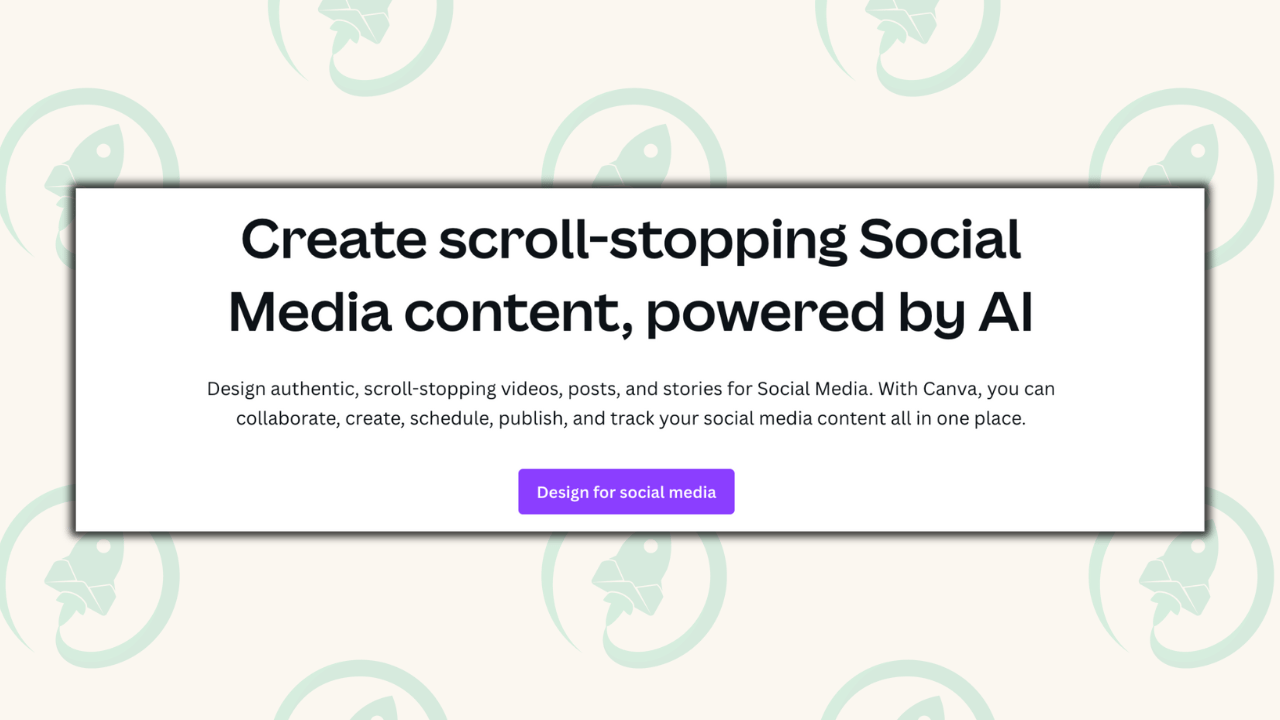
Leverage reciprocity 🎁
I feel like in every one of these deep dives there’s been a consistent golden thread:
Give. Give. Give.
In business, those who give the most get the most.
Want to build trust with potential customers?
Provide real value.
Want to convert more free users to paid users?
Provide more value.
Want to keep users happy and not churning?
Just keep providing value.
Make it seem silly for them to stop using your product.
Build a relationship with your users to the point where they don’t want to stop using your product. And not just because it serves their needs.
But because they also like you and your brand.
And why does giving value through content achieve this so well?
Because not only does it build trust, loyalty, and authority.
But it also leverages reciprocity.
Your users will want to give something of value to you (a referral, a share, or a subscription) because you first gave something of value to them (articles, newsletter, tools, videos, free features)
Reciprocity is powerful. Use it.
For The Zero to One, it’s been your host, Sheldon.
Speak soon and stay awesome!

